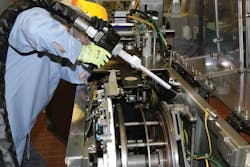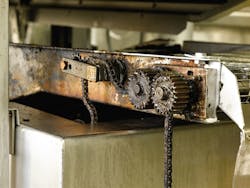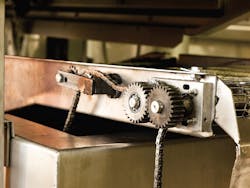The benefits of dry ice cleaning for food processing facilities
Dry ice cleaning is similar in concept to sand, bead and soda blasting in that it cleans surfaces using a media accelerated in a pressurized air stream. However, dry ice cleaning uses solid CO2 pellets or microparticles accelerated to high velocities to impinge on the surface and clean it. The particles sublimate upon impact, lifting dirt and contaminants off the underlying substrate without damaging equipment.
Traditional cleaning methods are time-consuming, labor-intensive and costly. Manual scraping or scrubbing with wire brushes and water or chemicals can consume many hours and result in extended downtime and can cause damage to equipment, shortening asset life and/or making it less productive.
Dry ice cleaning makes cleaning easier, more complete and enables food processing facilities to quickly and easily clean a number of different surfaces and get them back into production immediately.
The unique characteristics of dry ice make it an attractive solution for a food processor’s cleaning challenges:
No secondary waste
Cleaning with dry ice enhances sustainability efforts. It sublimates (turns from solid to gas) upon impact with the surface being cleaned, which means no secondary waste, no residue and no moisture is generated. This eliminates the added costs of extra cleanup, disposing of secondary waste streams and additional cleaning preparation, such as masking delicate sensors or wrapping electronic components prior to cleaning.
The cleaning process does not use water, which allows equipment to be cleaned while online and still operating. Because it is nonconductive, dry ice cleaning allows for electrical equipment to be safely cleaned.
Nonabrasive
Dry ice is a soft media and can clean sensitive electronic equipment, such as printed circuit boards, without etching, profiling or changing surface dimensions.
Nontoxic
Dry ice is a food-grade media and is approved by the Environmental Protection Agency, Food and Drug Administration and U.S. Department of Agriculture for use around food processing. It is colorless, tasteless, odorless and non-toxic. It allows for the elimination of environmentally harmful cleaning chemicals and eliminates worker exposure to hazardous cleaning agents. It also does not produce any toxic waste that must be disposed of.
Utilizing dry ice cleaning can result in cost savings, improved productivity, the extension of equipment life and improved worker safety.
Reduces costs
Dry ice cleaning reduces labor costs because it can be done in significantly less time than conventional manual labor. This enables a “cleaner” clean even in situations that are difficult or unpopular to clean by hand with conventional methods.
Improves productivity
Dry ice cleaning helps to reduce shutdown times, as equipment can be cleaned while hot and online. By cleaning equipment in less time, facilities can get more production cycles from existing equipment. Preventive maintenance or spot cleaning can also be done more frequently without impacting production.
Prolongs life of equipment
Dry ice cleaning is a dry process that is nonabrasive and nonconductive, meaning it won’t damage equipment and is safe for most surfaces, including electrical components.
Improves worker safety
Dry ice cleaning eliminates exposure to toxic cleaning materials. The process also eliminates repetitive motions of hand-cleaning or scrubbing, chiseling or activities that require pounding, sanding or scraping.
Dry ice cleaning in action
A Texas bakery was seeking a solution to its cleaning problem. In the company’s 125,000-square-foot baking facility, there are many issues for its quality assurance (QA) manager to worry about – from general maintenance and equipment repair to shelf life and product contamination. Keeping the facility and equipment clean is one of the most important tasks, but it is laborious and time-consuming.
The bakery’s biggest cleaning project included a mile-long bread cooler, which moves baked goods from the oven to an area for cooling and packing. The cooler was cleaned regularly by hand. Because of the plant’s constant operation, the conveyor and surrounding equipment were coated with layers of mineral oils and bread crumbs that had accumulated over time.
The plant used a combination of traditional cleaning methods, such as pressure washing and detailed hand-scraping. During a deep cleaning of the cooler, it took 25 people more than 10 hours to clean the entire length of the conveyor.
Before dry ice cleaning
After the deep clean, regular cleaning included pressure and hand washing, conducted by five laborers working 8- to 10-hour shifts. The regular cleaning has helped keep the surface of the stainless steel pins and rollers, the guides and the wear strips clean. Unfortunately, the general maintenance does not clean deep enough to completely remove the layers of residue from the other parts of the cooler, proofer, grids, baggers and floors. In addition, the pressure washing and manual wiping removes important mineral oils from the conveyor, which must be reapplied following the cleaning to ensure the conveyor is properly lubricated – a process which adds at least two hours of downtime.
The use of the pressure washer also required the company to wrap all electrical components prior to cleaning and then designate a few crew members to collect the water. The crew must remove all secondary wastewater and ensure that the equipment is completely dry before the parts can be reassembled and production could begin again.
“No matter how hard you try, water gets everywhere, and even after trying to remove the water, moisture remains,” said the QA manager. “In a baking environment, we are highly concerned about the long-term quality and shelf life of our products. Where there is moisture or buildup, there is a greater chance of a biological growing.”
After dry ice cleaning. Dry ice cleaning can quickly remove grease and other buildup.
Since implementing a dry ice cleaning system, the Texas bakery has seen an immediate return on investment. Cleaning the bread cooler and mile-long conveyor now takes two people less than six hours. Facility managers noted that they were also able to reduce their staffing in the sanitation department while the remaining crew is now able to focus on areas of the plant that the company hadn’t been able to clean previously. They estimated that by reducing the number of people and time required to clean the equipment by hand, they could recoup 24 to 30 hours per person per week that can be allocated to other cleaning and maintenance projects.
The cleaning process is soft enough that it doesn’t peel paint, impinge electrical conduit, damage the laser and infrared photo eyes used in production, or remove the mineral oils on the conveyor, yet is powerful enough to remove several years of built-up residue from production line machines.
The QA manager commented, “We simply did not have downtime to clean some pieces of equipment to our standards, but because of the speed and effectiveness of the dry ice system, we now have the time and resources to attend to a variety of other areas of the plant. Much of the equipment in a high-speed baking plant is simply not designed to be cleaned easily. With the dry ice system, we are cleaning things that I have never seen cleaned in the decade I have been in the industry. In fact, when I tell engineers what we are cleaning with dry ice, they are truly surprised.”
With the dry ice system, the plant does not have to worry about water residue anymore. Crew members no longer have to bag the electrical components, and they have also reduced the possibility of harmful biologicals. The QA manager said, “We do significant testing to determine how clean our equipment is after cleaning, and with dry ice cleaning, we are able to do more than simply removing debris. We are actually sanitizing our machines, which will have a positive impact on the long-term quality of our products and the life of our equipment.”
Tyson Marlowe is director of Global Training & Development at Cold Jet. Marlowe has been involved in researching, testing and implementing dry ice cleaning in many different industries for more than 16 years. He is also heavily involved in product development and improvement, as well as global business development.



